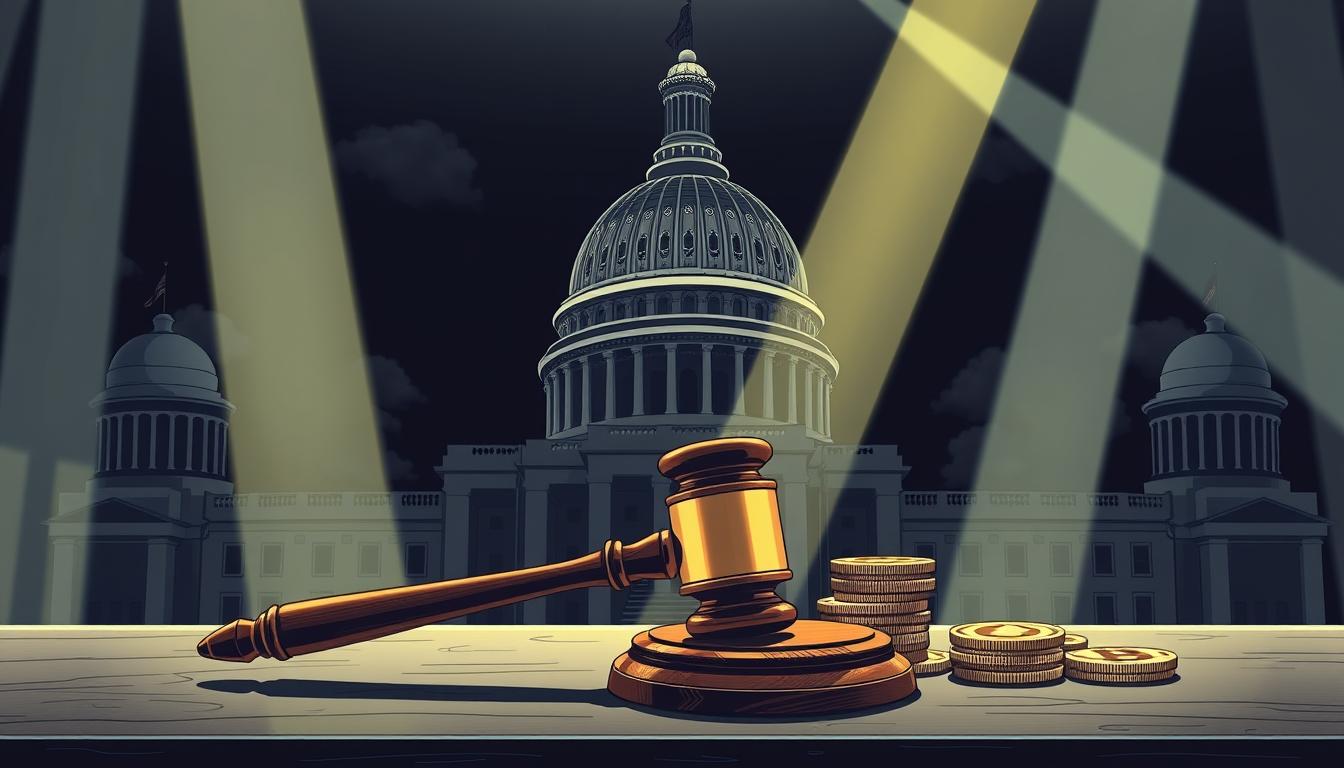The cryptocurrency market has seen huge ups and downs, with over $2 trillion in market capitalization changing quickly. This wild ride has worried investors and regulators, showing the need for clear rules.
The House just passed the Financial Innovation and Technology for the 21st Century Act (FIT21). This is a big step towards clarifying the regulatory landscape for digital assets. The GOP’s CFTC plan, part of FIT21, wants to make the market more stable. It plans to make it clear who does what between the CFTC and the SEC.
As you explore the changing world of cryptocurrency, knowing about this law is key. The new rules could change how you invest and the whole digital market.
Key Takeaways
- The GOP’s CFTC plan is a big deal in crypto regulation.
- FIT21 aims to clear up the rules for digital assets.
- A clear line of who does what between the CFTC and SEC is expected.
- The new law could make the cryptocurrency market more stable.
- It’s important to understand the impact of this law for investors.
The Current State of Cryptocurrency Regulation in the US
The US has a complex set of rules for cryptocurrencies. As the market grows, clear and detailed rules are more vital than ever.
Fragmented Regulatory Landscape
In the US, many agencies share the job of overseeing cryptocurrencies. The SEC and CFTC are the main ones, but their roles are not well-defined.
Multiple Agencies with Overlapping Authority
This confusion affects both investors and the market. SEC Chairman Gary Gensler said, “The SEC plays a key role in protecting investors in crypto.” Yet, it’s unclear who does what between the SEC and CFTC.
State and federal rules also differ. Some states have their own rules, while others don’t. This makes things even more complicated.
“The FIT21 bill aims to clarify the division of jurisdiction between these agencies and provide a more cohesive regulatory framework.”
This shows the need for a single set of rules to make the digital markets stable.
If you invest in or use cryptocurrencies, knowing these rules is key. It helps you move through the market smoothly.
Understanding the GOP’s CFTC Plan for Crypto Regulation
The GOP’s CFTC plan aims to make the digital asset market more stable. It does this by adding more rules and oversight. The plan is part of the Financial Innovation and Technology for the 21st Century Act (FIT21). It has several key parts to bring clarity and protect innovation and stability.
Key Components of the Proposed Framework
The GOP’s CFTC plan has a few main points. First, it defines digital assets clearly. This is important for knowing who is under the rules. It also sets up a way to regulate spot markets, which helps stop unfair trading and ensures fair play.
Timeline for Implementation
The plan’s timeline is key. It will affect how quickly the market can adjust to the new rules. It’s likely the rules will be introduced in phases. This will give everyone time to get used to the new rules.
Primary Objectives and Goals
The main goals of the GOP’s CFTC plan are to keep the market stable and protect new ideas.
Market Stability Priorities
Keeping the market stable is a big focus. The plan includes steps to stop unfair trading and ensure fair play. CFTC Chairman Rostin Behnam says, “Good rules are key to keeping the market honest and safe for everyone.”
“The CFTC’s role in overseeing digital assets is critical for maintaining market stability and preventing illicit activities.”
Innovation Protection Measures
The plan also protects new ideas. It makes sure rules don’t hold back new tech. Keeping the U.S. ahead in digital assets is important.
Knowing about the GOP’s CFTC plan helps you understand the changing rules. It helps you make smart choices about investing in digital assets.
How the CFTC Would Oversee Digital Assets Under the New Plan
The CFTC’s role in overseeing digital assets is about to grow a lot. A new plan aims to create a better regulatory environment for digital assets. It treats them as commodities, under the CFTC’s watch.
Expanded Authority and Responsibilities
The CFTC will now oversee spot markets and regulate digital assets as commodities. This move is expected to bring more clarity and stability to the digital asset market. The CFTC will ensure digital asset transactions are fair and transparent.
Regulatory Tools and Enforcement Mechanisms
The CFTC will use various regulatory tools to enforce compliance. This includes monitoring trading activities and investigating market manipulations. The agency can also impose penalties on non-compliant entities.
Differences from Current Oversight Structure
The new plan brings big changes to the current oversight structure. Two key areas of change are:
Changes to Commodity Definition
The proposal updates the commodity definition to include digital assets. This change brings regulatory clarity. It ensures digital assets are overseen like traditional commodities.
New Registration Requirements
Market participants must now register with the CFTC. This adds transparency and helps the agency monitor market activities. The registration process helps identify and mitigate risks in digital asset transactions.
These changes aim to strengthen the regulatory framework for digital assets. They enhance market integrity and protect investors.
The Role of Stablecoin Regulation in Market Stabilization
Stablecoin regulation is becoming a major player in making cryptocurrency markets more stable. As digital assets grow in popularity, strong rules are needed more than ever.
Stablecoins can affect market stability. To fix this, new rules for stablecoin makers are being suggested.
Proposed Stablecoin Standards
New standards aim to keep stablecoins’ value steady and clear. Key points include:
- Reserve Requirements: Stablecoin makers must keep enough reserves to back their coins.
- Transparency Measures: They must share regular audits and clear reports to follow rules.
Reserve Requirements and Transparency Measures
Keeping stablecoins stable is key. Issuers will hold reserves in safe assets like cash or government bonds. They also need to share their reserves and audit reports openly.
Impact on Stablecoin Issuers and Users
New rules will change things for both stablecoin makers and users. Makers will face higher costs to follow the rules. But users will feel more confident in stablecoins’ stability.
Regulators hope these steps will make the stablecoin market more stable and open. This will help the whole digital asset market.
Crypto Regulation, GOP CFTC Plan, Digital Markets Stabilization: Core Elements
The GOP’s CFTC plan aims to change how digital assets are regulated. It focuses on keeping markets fair and protecting consumers. This plan aims to make digital markets more stable by tackling major concerns.
Market Integrity Provisions
The plan includes important rules to keep markets fair. Anti-manipulation measures are part of it. These measures help stop fraud and keep trading honest.
Anti-Manipulation Measures
The CFTC plan wants to use advanced systems to catch and stop market manipulation. It will watch trading closely and spot any odd patterns.
Trading Surveillance Systems
Systems for watching trading will get better. They will keep an eye on digital asset markets in real time. This means they can act fast against unfair trading, making sure everyone trades fairly.
Consumer Protection Frameworks
A strong consumer protection plan is key in the GOP’s CFTC plan. It aims to protect investors with clear disclosure requirements and more openness.
Systemic Risk Management Approaches
The plan also tackles systemic risk by improving oversight of digital assets. It looks at risks and finds ways to lessen them. This helps keep the financial system stable.
The GOP’s CFTC plan wants to make digital assets more stable and secure. It aims to grow trust and confidence in the crypto market.
Bipartisan Efforts and Competing Crypto Legislation
Lawmakers from both sides are working together to shape crypto regulation. This is happening as different bills are being proposed. Finding a common ground on how to regulate crypto is urgent.
The Lummis-Gillibrand Bill Comparison
The Lummis-Gillibrand bill is a key example of bipartisan work. This bill aims to clarify how digital assets are classified. It also proposes a structure that supports innovation while protecting investors.
When compared to the GOP’s CFTC plan, there are both similarities and differences. Both aim to improve clarity in regulations. The Lummis-Gillibrand bill covers more areas of digital assets.
Areas of Political Consensus and Disagreement
Lawmakers agree on the need for clearer rules and better consumer protection. But, they disagree on who should oversee crypto. They also have different views on how to balance innovation and control.

Prospects for Compromise Legislation
The success of compromise legislation depends on finding common ground. As bipartisan efforts continue, a unified framework might emerge. This would address the crypto market’s complexities.
Through dialogue and teamwork, lawmakers can create a supportive environment for crypto. This environment should encourage innovation while safeguarding investors. Such a balance is essential for the future of crypto regulation in the U.S.
Industry Reactions to the GOP’s CFTC Plan
The GOP’s CFTC plan is sparking mixed feelings in the industry. People see it as a chance to stabilize the digital asset market. But, opinions vary on how well it will work.
Cryptocurrency Exchange Perspectives
Cryptocurrency exchanges are cautiously optimistic about the GOP’s CFTC plan. Exchanges like Coinbase and Gemini support clearer rules. They want regulations that fit the unique needs of digital assets.
DeFi Protocol Responses
The DeFi community has mixed views on the GOP’s CFTC plan. Some DeFi protocols see it as a chance to gain legitimacy and attract big investors.
- Governance token projects are watching how the rules will affect their governance.
- Lending and borrowing platforms worry about the impact on their work and DeFi’s liquidity.
Governance Token Projects
Governance token projects are keeping a close eye on the plan. They’re concerned about how it will change their governance and token systems.
Lending and Borrowing Platforms
Lending and borrowing platforms are weighing the risks and chances of the new rules. They’re looking at how it will affect their compliance and the market.
Traditional Finance Stakeholder Views
Traditional finance folks generally back the move to regulate crypto. They see it as a step towards a more stable market. They think clear rules will reduce risks and make it easier for big investors to join.
Potential Impact on Institutional Crypto Adoption
The GOP’s CFTC plan could greatly affect how institutions invest in crypto. It aims to bring regulatory clarity to the market. This is key as the crypto market grows and more investors look for clear rules.
Regulatory Clarity as a Catalyst for Institutional Investment
Clear rules could really boost crypto investment by institutions. The GOP’s plan sets out a clear path for digital asset rules. This could make crypto investments safer and more appealing to big investors.
Risk Assessment Changes Under the New Framework
The new rules from the GOP’s CFTC plan will change how institutions see risk in crypto. With clear guidelines, investors will find it easier to judge the risks and rewards of crypto.
Projected Timeline for Institutional Response
How fast institutions react to the GOP’s CFTC plan depends on a few things. These include how quickly the rules are made and how clear they are. But, once the rules are set, institutions will likely adjust their plans.
Banking Sector Adaptation
Banks will have a big role in institutions using crypto under the new rules. They’ll need to update their systems and rules to fit the new crypto landscape.
Asset Management Integration
Asset management firms will likely add crypto to their offerings as rules get clearer. This could lead to new financial products and services for big investors.
International Implications of US Crypto Regulation
The US is carefully watching its cryptocurrency rules. The GOP’s CFTC plan wants to make digital markets stable. But, its effects will likely spread to other countries.
Global Regulatory Harmonization Efforts
Many countries are trying to regulate cryptocurrencies together. The US’s rules could shape these global efforts. This might lead to a unified international regulatory system.

Competitive Positioning in the Global Crypto Landscape
The US’s crypto rules will affect its place in the world. A clear and stable framework could draw in investors and talent. This could make the US a key center for crypto innovation.
Cross-Border Compliance Considerations
As US crypto rules change, dealing with different countries’ rules will get harder. Companies working across borders face big compliance challenges. The US must balance innovation with strong consumer protection and financial stability.
Challenges and Criticisms of the GOP CFTC Approach
The GOP’s CFTC plan is facing many criticisms and challenges. It aims to stabilize digital markets but raises several concerns. People worry about its effectiveness and possible impact.
Potential Regulatory Gaps
One big worry is regulatory gaps that could be used by bad actors. Critics say the plan might not cover the crypto market’s complexities. This could lead to unforeseen risks.
Implementation Hurdles
Putting the CFTC plan into action is also tough. Resource and staffing concerns are major issues. The CFTC needs to grow its team to keep up with the fast-changing crypto world.
Resource and Staffing Concerns
Having enough resources and staff is key for the plan’s success. The CFTC must invest in new technology and people to manage the crypto market well.
Technical Expertise Requirements
Also, the CFTC needs specialized technical expertise. They must understand and regulate the complex crypto world.
Industry Concerns and Pushback
The crypto industry has many worries about the GOP’s CFTC plan. Some are afraid the rules could slow down innovation. They also worry about the extra work for smaller players in the market.
What This Means for You as a Crypto Investor or User
The GOP’s CFTC plan is important for you as a crypto investor or user. It aims to make digital markets more stable. But, it will also bring new rules and might affect market stability.
Compliance Requirements for Individual Investors
You’ll need to follow new rules, like reporting certain transactions. It’s key to know these rules to avoid penalties. The plan might also make KYC and AML rules stricter.
Expected Market Effects and Price Stability
The GOP’s CFTC plan wants to make the crypto market more stable. It aims to lower volatility and boost investor trust. But, how it works will depend on the rules’ details and how people react.
New Protections and Safeguards
The plan includes new investor protections. These include better fraud prevention and dispute resolution. These steps aim to protect your investments and help solve problems.
Fraud Prevention Mechanisms
The plan introduces stronger fraud prevention. This means tighter control over crypto exchanges and others. So, your investments will be safer.
Dispute Resolution Processes
For disputes, the plan offers better ways to solve them. This means clearer paths for fixing crypto investment issues. The goal is for these processes to be fair, open, and quick.
As rules change, staying up-to-date and adjusting is key for your success in crypto.
“The future of crypto regulation is not just about compliance; it’s about creating a more stable and secure environment for investors.”
Conclusion: The Future of Crypto Regulation in the United States
The future of crypto regulation in the United States is looking bright with the GOP’s CFTC plan. This move will make the digital asset world more stable and secure. The plan aims to bring clarity and oversight, which is key for the crypto future.
This new framework will deeply affect the industry. It will change how institutions invest and how individual investors feel. The GOP’s CFTC plan is set to guide the digital markets in the US.
A good regulatory framework is vital for growth, consumer protection, and staying competitive globally. As things progress, it’s clear that the US crypto regulation future will be shaped by laws, industry input, and market changes.
How Do the GOP’s CFTC Plans Reflect the Political Landscape Surrounding Digital Currencies and Traditional Banking?
The GOP’s CFTC plans highlight a significant shift in the political landscape, emphasizing the cautious integration of crypto currencies and banking. By regulating these digital assets, they aim to safeguard consumers while also providing a framework that encourages innovation, balancing traditional banking principles with the burgeoning crypto industry.
FAQ
What is the GOP’s CFTC plan, and how does it aim to stabilize digital markets?
The GOP’s CFTC plan, as outlined in FIT21, aims to bring stability to the digital markets. It does this by establishing a clearer division of jurisdiction between the CFTC and the SEC. This creates a complete regulatory framework for digital assets.
How will the new regulatory framework impact the division of jurisdiction between the CFTC and the SEC?
The FIT21 bill aims to clarify the division of jurisdiction between the CFTC and the SEC. It provides a clearer understanding of their roles in regulating digital assets.
What are stablecoins, and why is their regulation critical for market stability?
Stablecoins are digital assets pegged to the value of a traditional currency. Their regulation is critical for maintaining market stability. It protects users, as they can significantly impact the overall crypto market.
How will the CFTC’s new role impact its current oversight structure?
The CFTC’s new role will involve significant changes to its current oversight structure. This includes updates to the commodity definition and new registration requirements for market participants.
What are the prospects for compromise legislation on crypto regulation?
The prospects for compromise legislation depend on finding common ground between different political factions. The Lummis-Gillibrand bill is a notable example of bipartisan effort in crypto legislation.
How will the GOP’s CFTC plan impact institutional adoption of cryptocurrencies?
The GOP’s CFTC plan has the chance to increase institutional adoption of cryptocurrencies. It provides a clearer regulatory framework, leading to greater market stability and maturity.
What are the possible challenges and criticisms of the GOP’s CFTC plan?
The GOP’s CFTC plan faces several challenges, including regulatory gaps and industry pushback. These need to be addressed for successful implementation.
How will the new regulatory framework impact individual investors and users?
The new regulatory framework will introduce compliance requirements for individual investors. It may also impact market stability. It’s essential to understand these changes to navigate the evolving crypto landscape.
What is the significance of the Lummis-Gillibrand bill in crypto legislation?
The Lummis-Gillibrand bill is a notable example of bipartisan effort in crypto legislation. It shows the possibility of compromise and cooperation between different political factions.
How will the regulation of digital assets in the US impact the global crypto landscape?
The regulation of digital assets in the US will have a significant impact on the global crypto landscape. Other jurisdictions will closely watch the developments in the US.
What are the key elements of a complete regulatory framework for digital assets?
A complete regulatory framework for digital assets should include measures to prevent manipulation and protect consumers. It should also manage systemic risk. This provides regulatory clarity while protecting innovation and market stability.









































































































